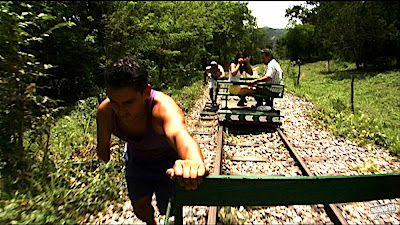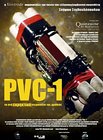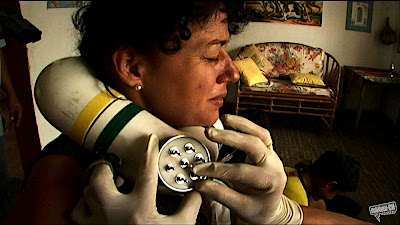Now Available on DVD
Before it became standard operating procedure on the real-time Fox hit series 24 that made us overlook lapses in logic concerning a main character who never has to go to the bathroom and the magical belief that it takes three minutes to drive anywhere in Los Angeles gridlock traffic, the technique of "real-time" filmmaking has had a culturally significant impact in a medium where logic has dictated that it's seldom used.
Since a film reel runs out after eleven minutes, it was quite a challenge to achieve in 1948 when the most famous real-time work arrived on celluloid. And the result of the painstaking process utilized to heighten a movie's tension-level to the extreme where events unfold in the exact amount of time that they should if you went by the ticking of the clock in conjunction with the film's running time was completed by none other than Alfred Hitchock in his famously experimental Rope.
Although it's a work that Hitch himself believed was a failure as he confided to Francois Truffaut in the book Hitchcock/Truffaut, Rope is still studied today for its daring decision to create a film from one continuous shot, using "reel time" to unspool the plot of the eerie Jimmy Stewart classic by letting the shot go for the length of one film reel until the next one picked up the action. And since Rope, real-time cinema has often been faked by directors and editors unafraid of cutting to avoid a static look but when the era of hand-held cameras came into vogue in the '90s and '00s, real-time came back in a variety of ways as viewed on TV's 24 as well as various cinematic offerings.
To this day, I think the most interesting one that's been released so far came from director Mike Figgis' fascinating four frame split screen work Time Code which divided the square shape into four frames and followed around actors in each one in real time although the viewer watches everything unfold all at once like we were watching security footage. Yet running a close second to the hyper-stylized Time Code is a much more naturalistic yet deeply unsettling contemporary psychological terror in the form of director Spiros Stathoulopoulos' PVC-1.
Using a GlideCam and filming across more than a mile of terrain, this meticulously well-rehearsed real-time work was captured digitally by the director who built up endurance for the Colombian shoot for three months and served as both his own cinematographer and sound engineer. Employing one single continuous take in its unspeakably nerve-wracking eighty-five minute running time with an explosive plot that's based on true events, we're ushered right into experiencing this psychological nightmare of human-nature gone seriously wrong.
Furthermore, Stathoulopoulos adds an element of heightened neorealist docudrama style to the shoot by deciding to cast a large amount of novices instead of well-known Latin film stars in what can only be described as the cinematic equivalent of a cardiac stress test. While eventually the film becomes overwhelmingly quiet, it begins with a lot of shouting, noise, and intensity in a surreal confrontation that finds a van filled with masked men who burst into a rural Colombian home for what we initially assume was a straightforward robbery but evolves into an outrageous ransom demand.
Since the father's neck is wider than expected, to illustrate their point in the most brutal manner, the masked attackers move directly to the mother whose neck they attach a blinking and beeping bomb embedded within thick PVC-1 tubing. Afterward, they throw a cassette tape on the floor and leave. Demanding fifteen million pesos as ransom and giving the family the usual warnings of following instructions to the letter and not going to the authorities, our protagonists have no choice but to go against their threat as the impoverished family has nowhere near the amount of money nor any reason to take the criminals who've vanished at their word.
Although the attackers phone the father later, the quick-thinking parents attempt to be strong and bring their eldest daughter with them as they journey to meet up with Colombian soldiers including one they hope can cut through the PVC-1 pipe and dismantle the bomb that has begun to emit high pitched noises at random. Obviously with all of this tension, there's not a lot of time for explanation, character set-up or back-story including just how, why, and what, if any connection the attackers had had to the poor family. In fact it's eerily quiet for a majority of the work as aside from a few breakdowns, trips, freak-outs, and just general fatigue, the dialogue is believably kept to the bare minimum as everyone instinctively goes into survival mode.
While I'd read that it would be a "real-time single-take" work back when I requested the screener, I somehow must've forgotten this before it arrived since I was so engrossed in the movie that it wasn't until I noticed the way the camera was following characters to clumsy running effect that it dawned on me that the cut didn't occur until the end. Accordingly this decision ensures it's tough enough from a viewer standpoint as you don't have a moment to catch your breath. But in the same turn, I was torn whether or not the process of endless motion which gave it a dizzying effect detracted from the movie like a superfluous gimmick for an event that was already heightened enough without the technique in the first place. Yet in the end for the material, I stand by the filmmaker's choice since ultimately it seems like the right way to do it justice by ensuring that the inhumanity of the event is driven home by making us live through in real time to understand and feel the way the real family did in 2000 when this occurred.
PVC-1 isn't a film you'll want to watch more than once in a short amount of time but it's nonetheless one you have to respect. As such, it's daring undertaking from all involved when you ponder the risks associated with the grueling shoot and patience needed by the cast and crew. The film festival award winning work which premiered at Cannes in '07 and earned the Director's Fortnight Award before going onto further success around the globe, PVC-1 has finally finished its festival circuit journey to DVD courtesy of MPI Media Group and IFC Entertainment. Despite the lack of special features including the absence of what I know would've been a highly coveted behind-the-scenes featurette or filmmaker interview, the work which is in Spanish with English subtitles and the original widescreen aspect ratio is presented in a high quality transfer to make its US debut on DVD two years after it startled audiences across the ocean.
Text ©2009, Film Intuition, LLC; All Rights Reserved. http://www.filmintuition.com
Unauthorized Reproduction or Publication Elsewhere is Strictly Prohibited.




















